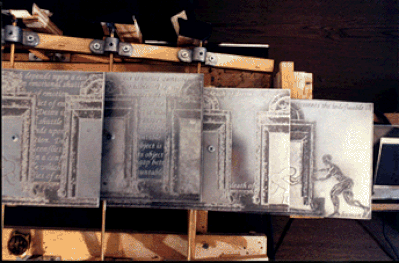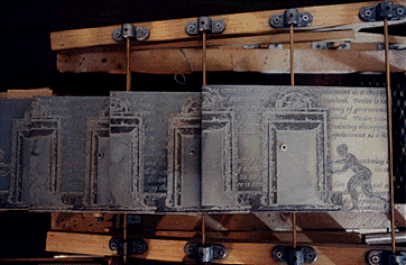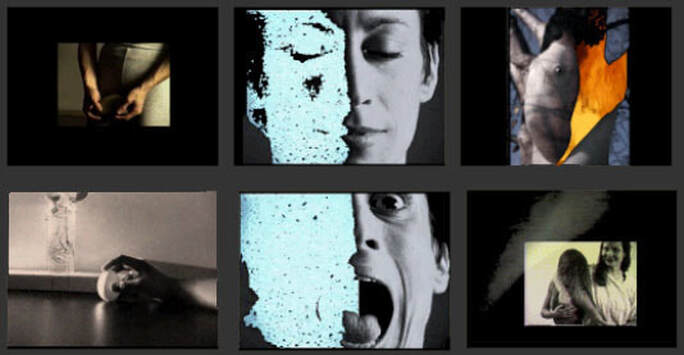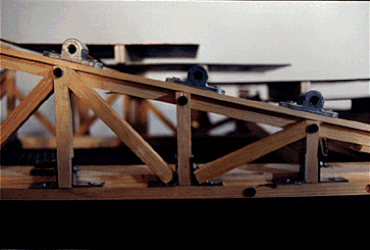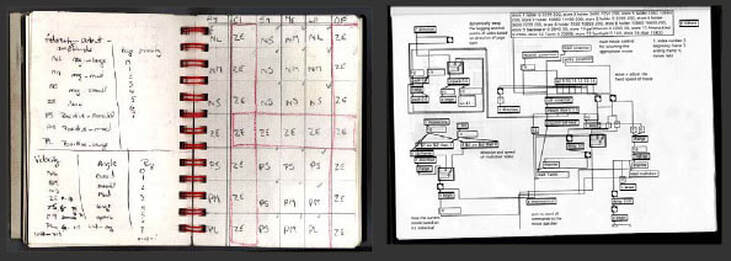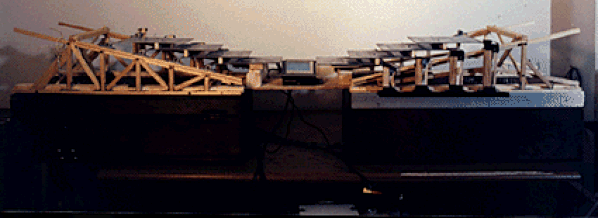PAMELA L. JENNINGS, PHD
|
PAMELA L. JENNINGS Ph.D., MBA
|
the book of ruins & desireInteractive Mechatronic Sculpture, (1996).
62 x 18 x 14 inches |
This work was created for my MFA in Computer Arts thesis at the School of Visual Arts, New York City.
|
View of the mounted photoetched plates from above.
The interactive book is a term heard frequently in reference to early experiments in CD ROM production. But how to translate the concept of the book into a medium that has no paper, no pages remains a challenge. Is not a book an object one holds in his/her hands -- the cover effected over time by the acids and oils perspiring from the users skin, pages turned down and yellowed, torn or marked up? Research could show that the notion of the traditional book has been challenged throughout history. But this challenge has been accelerated with the growing accessibility of new computer interactive and information technologies.
The words engraved on the printed page raise curiosities in our imaginations. For some readers, their minds are teleported to a place where the words and their imaginations mingle and twist about each other -- creating new notions of experience and reality. The optimum environment for this kinetic sculpture is a darkened room. In the center of the room stands a simple table with the sculpture object on top. Murmuring from its proximity is a barely audible voice whispering "touch me." This to draw the user closer to the object and give permission to touch the object. When the sculptural object registers the human touch the sound track changes from "touch me" to gentle breathing. The manipulator of the object, as the director of the experience, will proceed in composing his/her own collage of imagery and sound by turning the hinged pages.
|
Embedded in the wooden cabinet below the scaffold for the book pages is a set of stereo speakers. Placed in between the two sets of metal etched pages is a small video monitor.
When there is no interaction and all of the pages are closed a video of a black wave is played. As soon as a page is turned the video changes to the spinning rotunda and my hands holding and dropping white pebbles. If the book is left on touched with all of the pages open an animation of the Pythagorean theory is played. Once a page is completely opened a content video is played. There are eight content videos. All but two of them are videos set twice to a selection of songs from Ned Rorem’s song cycle Poems of Love in the Rain. Ned Rorem set each of the poems in the cycle twice to piano accompaniment, claiming that there was no one perfect accompaniment for the poetry. I complemented his claim by setting his music twice to video. The other two videos are set to a song by Samuel Barber titled Sleep Now. The visuals are lush in this work, but sound is even more important. As the pages are turned the qualitative (volume and panning) variables of personal and academic text written about the topic of desire are played. An embedded synthesizer plays algorithmically composed sounds to every interaction taken with the book. |
Stills from video chapters.
Technical Overview - Fuzzy Logic
|
The "book of ruins and desire," is a simple object run by a complex system of 68hc11 microprocessor technology and fuzzy logic, which ultimately controls audio and video processes performed in the midi programming language Opcode MAX. Manipulating its pages triggers a visual or audio response on a monitor embedded inside the object. The physical book is made from several materials including metal etched plates and wood. All of the operating technology, except the Macintosh computer are embedded inside the sculptures cabinet.
|
The book of ruins and desire is operated through several layers of code. The 68hc11 microprocessor board is programmed with C. The Fuzzy Logic inference engine was developed using a freeware package from Motorola called Fudge. Individual potentiometers are permanently fixed to rods that support the pages. Their readings are interpreted through the inference engine and three sets of numbers are produced. The sets of numbers describe the page being moved, its angle and direction of movement. This data is read into Opcode Max and converted into code that drives video and sound files and midi data. Midi data is created using components of the Real Time Composing Library developed by Karlheinz Essl. This library of MAX objects was developed to allow composers to use algorithmic and serial methods of music making.
Copyright © 1990 - 2024
